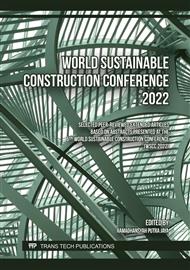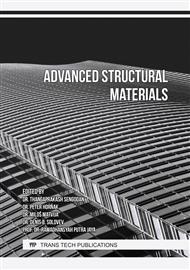[1]
A. Thakur and R. Bedi, Influence of process parameters on microwave joining of the similar/dissimilar materials: A review, Mater. Today: Proc. (2022).
DOI: 10.1016/j.matpr.2022.03.428
Google Scholar
[2]
B.R. Reddy, V. Sridevi, T.H. Kumar, C.S. Rao, V.C.S. Palla, D.V. Suriapparao, and G.S. Undi, Synthesis of renewable carbon biorefinery products from susceptor enhanced microwave-assisted pyrolysis of agro-residual waste: A review, Process Saf. Environ. Prot. 164, (2022) 354-372.
DOI: 10.1016/j.psep.2022.06.027
Google Scholar
[3]
S. Singh, D. Gupta, V. Jain, and A.K. Sharma, Microwave processing of materials and applications in manufacturing industries: A review, Mater. Manuf. Processes. 30, 1, (2015) 1-29.
DOI: 10.1080/10426914.2014.952028
Google Scholar
[4]
D. Grekov, P. Pré, and B.J. Alappat, Microwave mode of heating in the preparation of porous carbon materials for adsorption and energy storage applications–an overview, Renew. Sustain. Energy Rev. 124, (2020) 109743.
DOI: 10.1016/j.rser.2020.109743
Google Scholar
[5]
Y. Sun, Adaptive and intelligent temperature control of microwave heating systems with multiple sources. KIT Scientific Publishing, 2016.
Google Scholar
[6]
D.K. Patel, N.K. Bhoi, and H. Singh, Microwave heating capabilities of different susceptor material: Experimental and simulation study, Silicon. (2021) 1-15.
DOI: 10.1007/s12633-021-01426-4
Google Scholar
[7]
T.P. Naik, I. Singh, and A.K. Sharma, Processing of polymer matrix composites using microwave energy: A review, Compos. Part A: Appl. Sci. Manuf. (2022) 106870.
DOI: 10.1016/j.compositesa.2022.106870
Google Scholar
[8]
M. Biesuz, T. Saunders, D. Ke, M.J. Reece, C. Hu, and S. Grasso, A review of electromagnetic processing of materials (epm): Heating, sintering, joining and forming, J. Mater. Sci. Technol. 69, (2021) 239-272.
DOI: 10.1016/j.jmst.2020.06.049
Google Scholar
[9]
P.K. Loharkar, A. Ingle, and S. Jhavar, Parametric review of microwave-based materials processing and its applications, J. Mater. Res. Technol. 8, 3, (2019) 3306-3326.
DOI: 10.1016/j.jmrt.2019.04.004
Google Scholar
[10]
M.J. Troughton, Handbook of plastics joining: A practical guide. William Andrew, 2008.
Google Scholar
[11]
S. Staicovici, C.-Y. Wu, and A. Benatar, Welding and disassembly of microwave welded hdpe bars, J. Reinf. Plast. Compos. 18, 1, (1999) 35-43.
DOI: 10.1177/073168449901800104
Google Scholar
[12]
R. Wise and I. Froment, Microwave welding of thermoplastics, J. Mater. Sci. 36, 24, (2001) 5935-5954.
Google Scholar
[13]
S. Poyraz, L. Zhang, A. Schroder, and X. Zhang, Ultrafast microwave welding/reinforcing approach at the interface of thermoplastic materials, ACS Appl. Mater. Interfaces. 7, 40, (2015) 22469-22477.
DOI: 10.1021/acsami.5b06484
Google Scholar
[14]
X. Sun, G. Wu, J. Yu, and C. Du, Efficient microwave welding of polypropylene using graphite coating as primers, Mater. Lett., 220, (2018) 245-248.
DOI: 10.1016/j.matlet.2018.03.046
Google Scholar
[15]
X. Sun, J. Yu, and G. Wu, Study on microwave welding of polypropylene by carbon nanotube, Integr. Ferroelectr. 197, 1, (2019) 16-22.
Google Scholar
[16]
P.Y. Foong, C.H. Voon, B.Y. Lim, M.K.M. Arshad, S.C. Gopinath, K.L. Foo, R.A. Rahim, and U. Hashim, Feasibility study on microwave welding of thermoplastic using multiwalled carbon nanotubes as susceptor, Nanomater. Nanotechnol. 11, (2021) 18479804211002926.
DOI: 10.1177/18479804211002926
Google Scholar
[17]
B. Zhong, J. Zhang, H. Wang, L. Xia, C. Wang, X. Zhang, X. Huang, and G. Wen, Fabrication of novel silicon carbide‐based nanomaterials with unique hydrophobicity and microwave absorption property, Int. J. Appl. Ceram. Technol. 17, 6, (2020) 2598-2611.
DOI: 10.1111/ijac.13583
Google Scholar
[18]
T. Han, R. Luo, G. Cui, and L. Wang, Effect of sic nanowires on the high-temperature microwave absorption properties of sicf/sic composites, J. Eur. Ceram. Soc. 39, 5, (2019) 1743-1756.
DOI: 10.1016/j.jeurceramsoc.2019.01.018
Google Scholar
[19]
J. Kuang, P. Jiang, X. Hou, T. Xiao, Q. Zheng, Q. Wang, W. Liu, and W. Cao, Dielectric permittivity and microwave absorption properties of sic nanowires with different lengths, Solid State Sci. 91, (2019) 73-76.
DOI: 10.1016/j.solidstatesciences.2019.03.015
Google Scholar
[20]
R. Wu, K. Zhou, C.Y. Yue, J. Wei, and Y. Pan, Recent progress in synthesis, properties and potential applications of sic nanomaterials, Prog. Mater. Sci. 72, (2015) 1-60.
DOI: 10.1016/j.pmatsci.2015.01.003
Google Scholar
[21]
R. Selvam, S. Ravi, and R. Raja, "Fabrication of sic particulate reinforced polyester matrix composite and investigation," in IOP Conference Series: Materials Science and Engineering, 2017, vol. 197, no. 1, p.012052: IOP Publishing.
DOI: 10.1088/1757-899x/197/1/012052
Google Scholar
[22]
A. Kumar, V. Agarwala, and D. Singh, Effect of milling on dielectric and microwave absorption properties of sic based composites, Cerami. Int. 40, 1, (2014) 1797-1806.
DOI: 10.1016/j.ceramint.2013.07.080
Google Scholar
[23]
G. Liu, L.Y. Wang, G.M. Chen, W.N. Wei, C.Q. Ge, and H. Zhang, "Comparison study on microwave absorbing properties of sic absorbers. Appl. Mech. Mater. 117, (2012) 1057-1060.
DOI: 10.4028/www.scientific.net/amm.117-119.1057
Google Scholar
[24]
C. Wang, T. Chen, S. Chang, S. Cheng, and T. Chin, Strong carbon‐nanotube–polymer bonding by microwave irradiation, Adv. Funct. Mater. 17, 12, (2007) 1979-1983.
DOI: 10.1002/adfm.200601011
Google Scholar
[25]
C.Y. Wu and A. Benatar, Microwave welding of high density polyethylene using intrinsically conductive polyaniline, Polym. Eng. Sci. 37, 4, (1997) 738-743.
DOI: 10.1002/pen.11717
Google Scholar
[26]
R. Xie, J. Wang, Y. Yang, K. Jiang, Q. Li, and S. Fan, Aligned carbon nanotube coating on polyethylene surface formed by microwave radiation, Compos. Sci. Technol. 72, 1, (2011) 85-90.
DOI: 10.1016/j.compscitech.2011.10.003
Google Scholar



